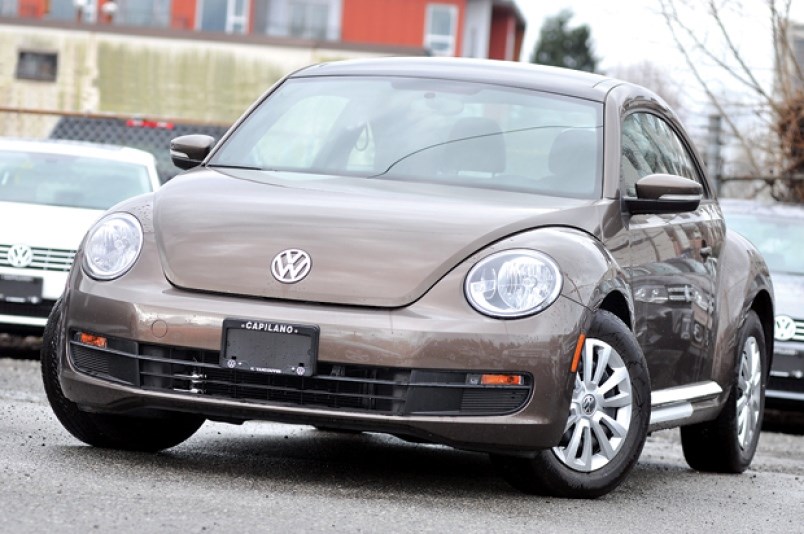A biweekly roundup of automotive news, good, bad and just plain weird:
The VW Beetle is finally dead
They say bugs will outlive us all, and in the case of the Volkswagen Bug, there seemed to be a certain truth to the cliché. Canadians got the VW Beetle a little earlier than our cousins to the south, and we were soon smitten by the original's air-cooled thrift.
However, the front-wheel-drive Golf soon surpassed the Beetle in modern feel, so off the old one went to the big scrapyard in the sky. Except, that is, for the Mexican market, where air-cooled Beetles persisted until 2003.
Despite killing off the original with an extra large can of bug spray, Volkswagen was not immune to the nostalgia craze of the 1990s, and produced the New Beetle. Basically just a Golf in a bug suit, the New Beetle has one of the strangest dashboards ever, thanks to packaging requirements. Not to mention the flower vase.
Even so, it was charming in its way, and mostly as good as a Golf. So, when VW discontinued it, there was a bit of a hue and cry to bring back another modern Beetle. And VW did, but it was a little less cute than either of the first two. Sales slowly dwindled.
Now, VW has finally declared the Beetle kaput, and there are no projected replacements. It's a sad time if you like VW for something other than crossovers.
But take heart. VW's electric vehicle program is just on the horizon, and its low-mounted modular powertrains could easily accommodate a Beetle-shaped tribute to the past. Bring your own flower vase.
Ontario man stopped for using beer booster seat
There are many things you can do with a 30-pack of beer besides drinking it. Get a friend to help you move. Pay back your neighbour for the use of his lawnmower. Ensure you always get invited back to parties.
Beer: is there anything it can't do? Well, yes. It makes a lousy booster seat.
That's what one Ontario man found out when he was pulled over by police, and cited for using a 30-pack of beer as a booster seat for his two-year-old son. Also not ideal, though not illegal: the stop occurred at 2:30 a.m.
To their credit, the OPP went and fetched a child seat to help everyone get home safely. And, one expects, they were able to call on their training to maintain a straight face when making the public safety announcement: please do not use beer to secure your children.
The age of the hypercar approaches
For those of you who think that all the best cars have already been built, please witness the new Aston Martin Valkyrie, unleashed last week for a demo lap at the British Grand Prix. Powered by a naturally aspirated 6.5-litre V-12 built by Cosworth, the Valkyrie has a shocking 1,160 horsepower, and screams like its namesake.
What's the point? Well, the Valkyrie and cars like it are part of a new World Endurance Championship category called hypercars. Instead of prototypes that show technological prowess that doesn't always translate, the hypercar class is supposed to be based around incredibly fast cars that you can actually buy.
Well, I say “you.” The Valkyrie and its ilk are going to be Quite Expensive. Think of the old GT1 series, where pretty much everything started at a million dollars and went up from there.
Even so, it's hard not to cheer for the old-school appeal of a naturally aspirated V-12, meshed with high-tech aerodynamics and composite-fibre chassis technologies.
Lotus unveils all-electric supercar
And what of the old-fashioned British supercar? It's gone high-tech too. Meet the new Lotus Evija. It's got all the expected supercar attributes – top speed over 200 miles per hour, vents and wings, blistering acceleration – but with a twist. It's electric.
In times past, the words “electric” and “Lotus” were almost always followed by the word “problem.” Actually, that'd apply to times present as well.
However, a high-performance EV like the Evija is actually quite simple from a moving-parts perspective, and might actually be the most reliable Lotus ever made. Which is setting the bar low to the point of burying it in a small ditch, but still.
Further, the Evija is also going to be comically powerful (1976 h.p.) and a little bit heavy. It'll have all-wheel-drive thanks to its four electric motors, and will doubtless employ all sorts of traction control trickery.
Is it just me, or shouldn't we be looking to Lotus for something outside the usual huge-power electric acceleration numbers? What about lightness, the company's calling card, and the Achilles' heel of any EV. Wouldn't it be more fun to have a little electric Elise with around 200hp that worked every time you wanted it to? Dare to dream.
Watch this space for all the week's best and worst of automotive news, or submit your own auto oddities to [email protected].



